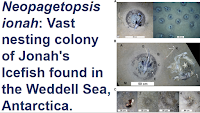An iceberg known as A23a, considered to currently be the largest in the world, with a surface area of about 4000 km² and a thickness of about 400 m, has begun to move, after remaining grounded within the Weddell Sea for several decades. The iceberg was one of a cluster that broke away from the Filchner Ice Shelf in November 1986, prompting the emergency evacuation of a Russian science station which was located on the breakaway part of the ice, but subsequently became grounded in the shallow waters of the Weddell Sea. The iceberg subsequently moved a short way in 2020, but again became grounded. It has now begun moving again, and appears likely to move out of the Weddell Sea and into the Antarctic Circumpolar Current, which will carry it west towards South Georgia and South Africa.
The increased rate of movement and break up of many ice sheets, which leads to the formation of icebergs, is thought to be directly connected to rising global temperatures. However, the movement of icebergs once they have formed is less well understood and it is unclear to what extent these events are climate driven. Icebergs from the Antarctic Peninsula and Ronne Ice Shelf typically become trapped in the Weddell Sea for many years, before migrating into the Antarctic Circumpolar Current. Icebergs in this, slightly warmer, current will tend to melt over time, but can drift a long way first, sometimes becoming stranded off South Georgia or even drifting into the shipping lanes around South Africa.
See also...
Follow Sciency Thoughts on Facebook.
Follow Sciency Thoughts on Twitter.







